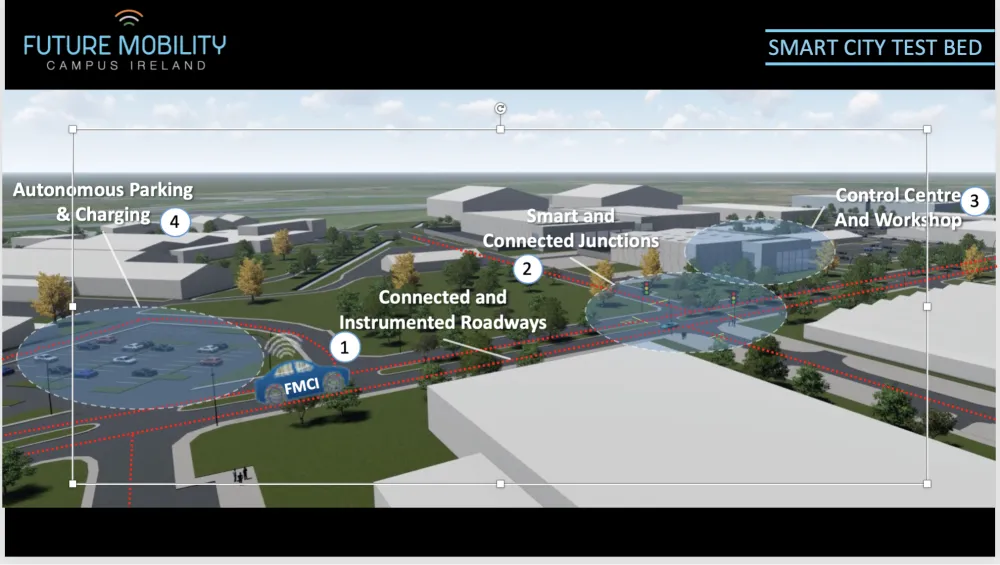Vehicles that drive themselves using new forms of power. Traffic signals that talk to cars. Highways and city streets with zero accidents and zero congestion. From changing lifestyles to concerns about climate change, a number of trends are converging to transform yesterday’s science fiction into today’s reality. Recently, automakers along with governments and technology companies have joined in a dash toward the future of mobility. In one example, the picturesque landscape near Limerick, Ireland has become a hotbed for automotive and smart city innovation.
A new Future Mobility Campus Ireland (FMCI) on the outskirts of the town of Shannon is planned to include a collaborative testbed spread across eight miles (12km) of public roads. It is also planned to incorporate smart junctions and connected car parks with shared vehicle parking and electric car charging stations. The initiative is set to feature smart links to a 280-mile (450km) stretch of connected highway and a managed air traffic corridor for unmanned aerial vehicles (UAVs)— drones—from Shannon airport. The design for the real-world facility calls for sensors throughout the site, along with high-accuracy location systems, a data management and control center, and self-driving prototype vehicles. More at https://futuremobilityireland.ie.

Jaguar Land Rover, the UK’s largest automotive manufacturer, has announced a collaboration with FMCI to innovate a new wave of mobility at the Shannon facility. Red Hat is a founding member of the nonprofit FMCI organization. FMCI collaborative ecosystem plans to provide the infrastructure and expertise to harness valuable sensor data, simulate a variety of road environments and traffic scenarios, and allow real-world trials of new technologies.
Four key drivers of today’s automotive innovation
The FMCI initiative focuses on the impact of four main disruptive forces in the automotive sector: connected, autonomous, and electric vehicles as well as shared mobility.
Connected
Vehicles are increasingly becoming connected via the internet and the cloud—not only to traffic management infrastructure but also with other cars. In the future, vehicles may also connect with passengers and pedestrians.. By communicating with smart city infrastructure, this connectivity can also help to eliminate traffic congestion, saving not only time and frustration but might save energy by requiring vehicles to spend less time in traffic.
Autonomous
There is a spectrum of vehicular autonomy that ranges from none at all to fully autonomous. The levels range from some driver assistance, such as intelligent cruise control and self-steering to keep inside lanes, to a fully autonomous experience where the driver essentially becomes a passenger.
While the levels of autonomy will probably be available in phases, various regulations in Europe and around the world could drive the trend more quickly up to level 2 or 3. In any case, automakers must adapt them to provide customers with a secure and safe experience and governments need to play a part as well. This is one goal of research at the Shannon campus.
Electric
Concerns about climate change and air pollution have created a growing demand for cleaner vehicles. Among other programs, the FMCI campus will include charging networks for electric vehicles as well as autonomous car parking areas The campus simulates real world city environment for testing emerging new technologies.
Shared
While many people love their cars, they don’t actually use them very often. The average vehicle stays parked 95% of the time. So, it’s not surprising that a study by Ing found that sixty percent of Europeans out of 13,000 consumers in 13 different countries asked for their view stated they would gladly share their car for a little extra money. According to the same study, 30% of those surveyed with a driving license showed interest in using car sharing services. The Shannon facility will include car parks and also explore internet-connected technologies to facilitate sharing.
Technology, infrastructure and collaboration
“The smart city zone provides a first-class facility for global companies to work together and develop world-leading technology, from autonomous vehicles to connected infrastructure,” says Russell Vickers, CEO of FMCI. “The testbed provides an opportunity to test in the real world and help answer some of the questions posed by the future of mobility in a collaborative and efficient way.”
In addition to these future-focused goals, the FMCI initiative is set to provide near-term practical applications. For example, cars coming into Ireland or the UK, both left-hand drive countries, will require testing to ensure they comply with a variety of new regulations around areas such as safety. The FMCI campus promises to provide an excellent test center for these types of certifications.
Red Hat is excited to be part of the community of partners we're engaged with at FMCI. We believe we can apply Red Hat's leading expertise in open source projects like Linux and Kubernetes to find innovative use cases where open source technologies can be the foundation for next-generation innovation in automotive and mobility.
 Red Hat open software solutions provide the foundation for mobility innovation at FMCI
Red Hat open software solutions provide the foundation for mobility innovation at FMCI
Red Hat is proud to be collaborating with FMCI and its partners in creating real-world test beds for future mobility. Red Hat open source software components form the key infrastructure foundation for the FMCI campus and related mobility testbeds such as motorways and drone routes. These solutions include cloud-connected monitoring and control systems as well as edge computing that pushes data center functions to edge devices, such as connected cars. Also, as a leader in software infrastructure for the telecom space, Red Hat can also enable advanced capabilities for 5G over the air (OTA) software updates.
“Red Hat is excited to be part of the community of partners we're engaged with at FMCI. We believe we can leverage Red Hat's leading expertise in open source projects like linux and kubernetes to find innovative use-cases where open source technologies can be the foundation for next-generation innovation in automotive and mobility.” Keith Lynch, Country Manager, Red Hat Ireland.
About Future Mobility Campus Ireland (FMCI)
FMCI was founded with the sole purpose of creating and delivering future mobility testbed facilities for stimulating research, development and innovation in the area of Autonomous Connected Electric Shared Vehicles (ACES), including Connected and Autonomous Vehicles (CAV) in Ireland. The testbed will be located in the Limerick-Shannon metropolitan area at Shannon Free Zone, Shannon, Co.Clare
FMCI aims to deliver an ACES test facility located in real-world settings, providing technology companies and researchers the ability to test and enhance their innovations. The test facility consists of a road network that is retrofitted with interconnected state of the art sensing and telecommunication technologies. These edge technologies are fully accessible and controlled via a dedicated control centre. The target users/customers of this facility include national and international automotive and technology providers that are interested in testing their innovations in real-world settings before the product release phase. Learn more at Future Mobility Campus Ireland.
執筆者紹介
Keith Lynch heads up Red Hat's Enterprise business in EMEA, helping customers to take advantage of open source to accelerate innovation and transform business models. Lynch believes that getting technology choices right is less than half the battle – organisational change and technology delivery can be far more disruptive and difficult to deliver. When open source principles are applied to culture, they can be a catalyst for change in people and process as they are in technology. He is passionate about defaulting to open, whether that applies to code or culture.
Florian Moss is a solution architect working for Red Hat in Ireland. He is just as passionate about software development as he is about IT infrastructure and large scale automation.
Nischal Muchakani manages Red Hat’s ecosystem for the automotive industry. He is responsible for strategic relationships and partnerships with the auto ecosystem, which includes Tier suppliers, startups, consortiums, cloud providers, mobility services, and network providers. Prior to Red Hat, Muchakani worked at Intel. He has more than 20 years of experience in the automotive industry and has held various technical, project management, sales, and business development roles with leading automotive clients in various geographies.
Alistair Veltom joined Red Hat in 2015, and has held business development roles in APAC and EMEA.
チャンネル別に見る
自動化
テクノロジー、チームおよび環境に関する IT 自動化の最新情報
AI (人工知能)
お客様が AI ワークロードをどこでも自由に実行することを可能にするプラットフォームについてのアップデート
オープン・ハイブリッドクラウド
ハイブリッドクラウドで柔軟に未来を築く方法をご確認ください。
セキュリティ
環境やテクノロジー全体に及ぶリスクを軽減する方法に関する最新情報
エッジコンピューティング
エッジでの運用を単純化するプラットフォームのアップデート
インフラストラクチャ
世界有数のエンタープライズ向け Linux プラットフォームの最新情報
アプリケーション
アプリケーションの最も困難な課題に対する Red Hat ソリューションの詳細
仮想化
オンプレミスまたは複数クラウドでのワークロードに対応するエンタープライズ仮想化の将来についてご覧ください




